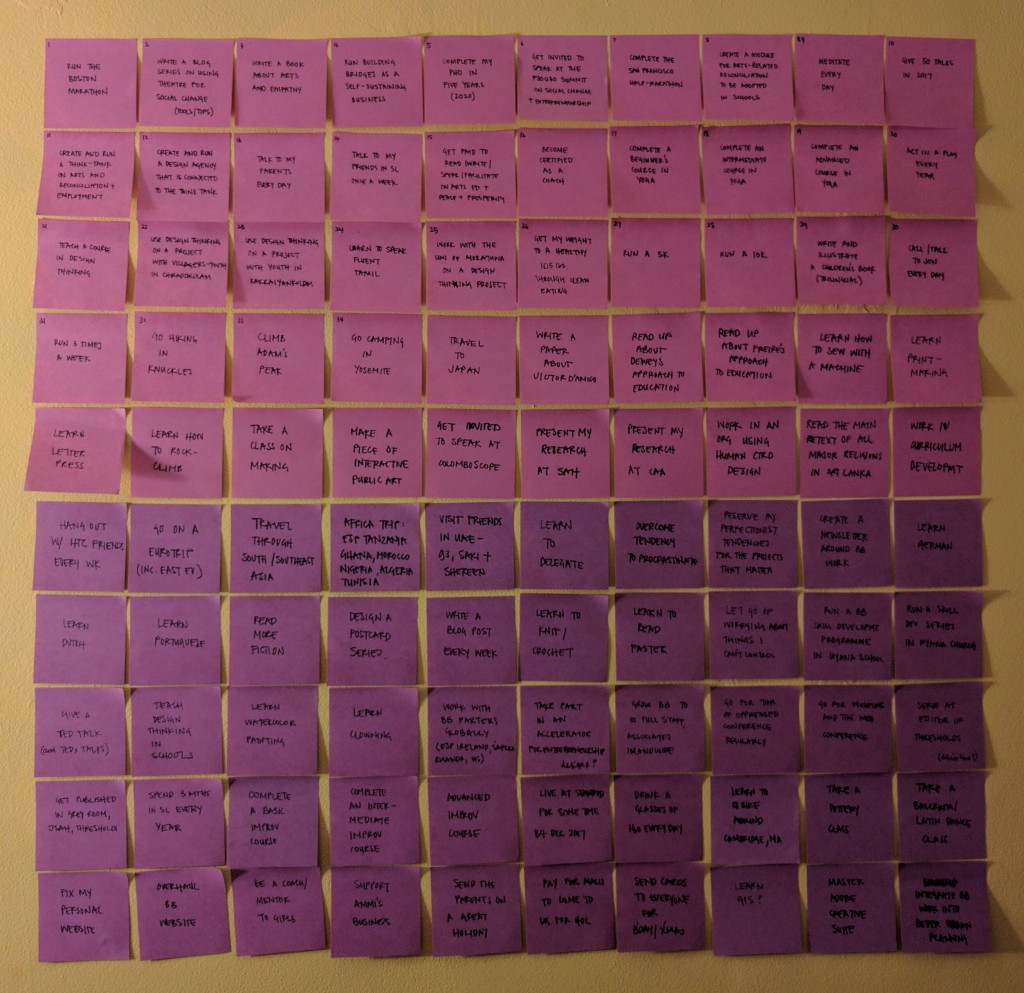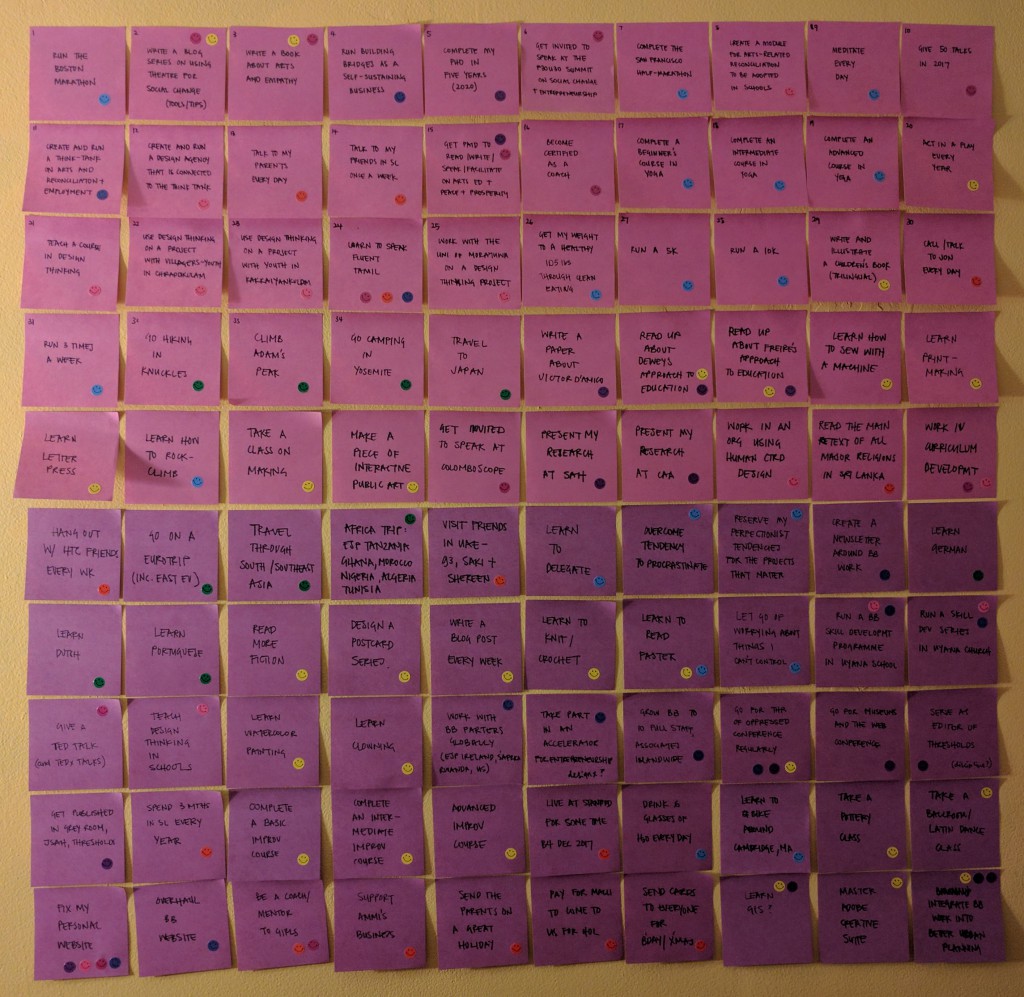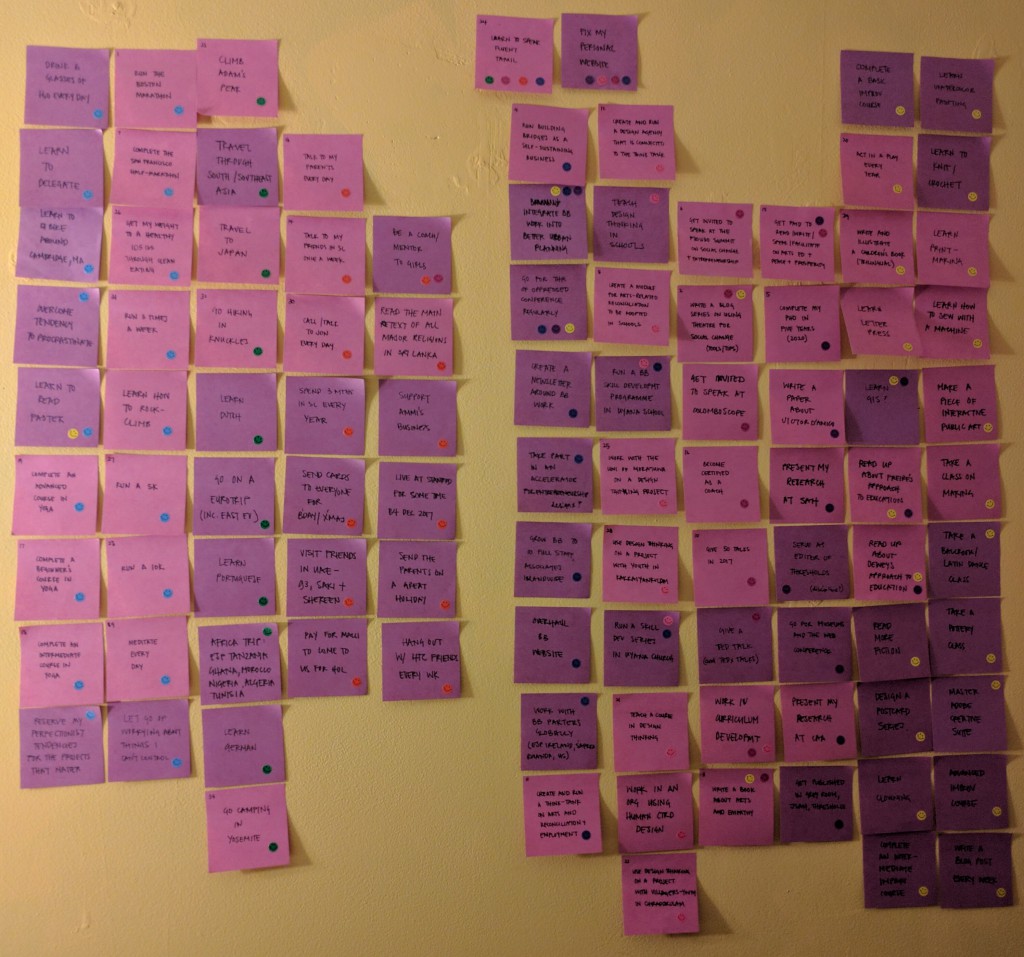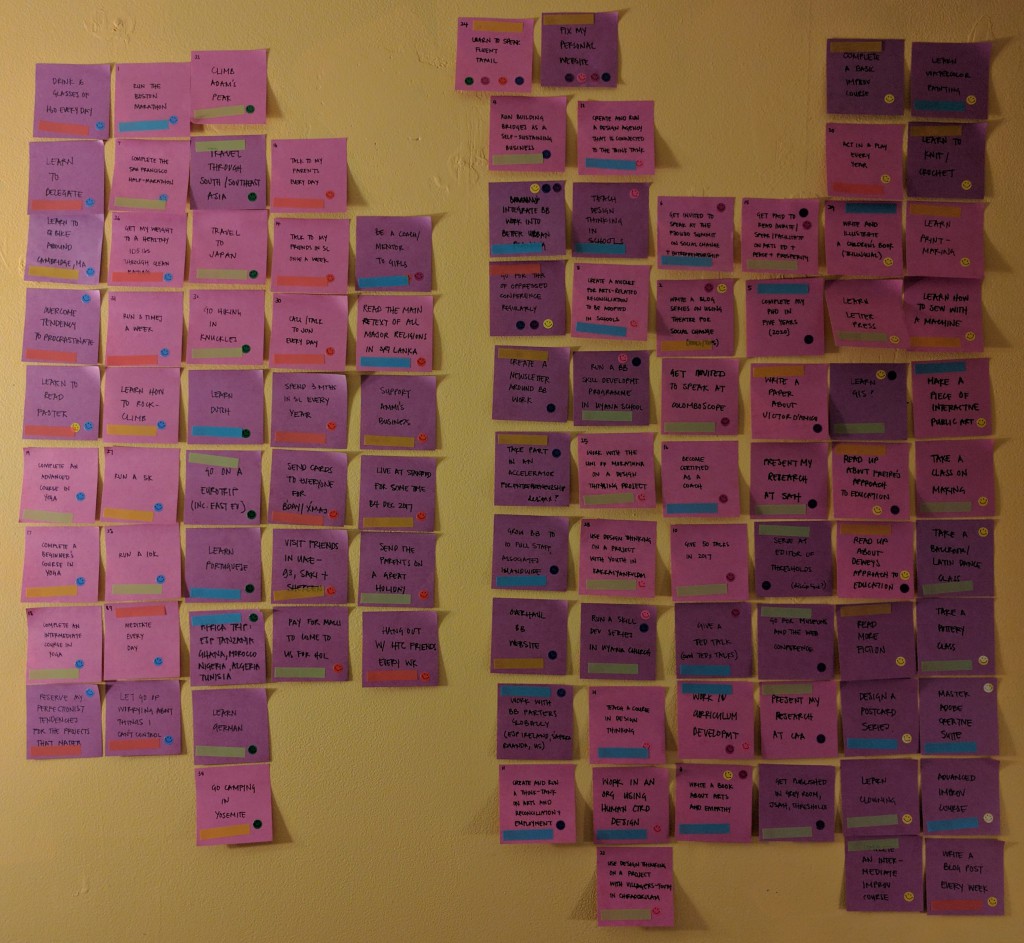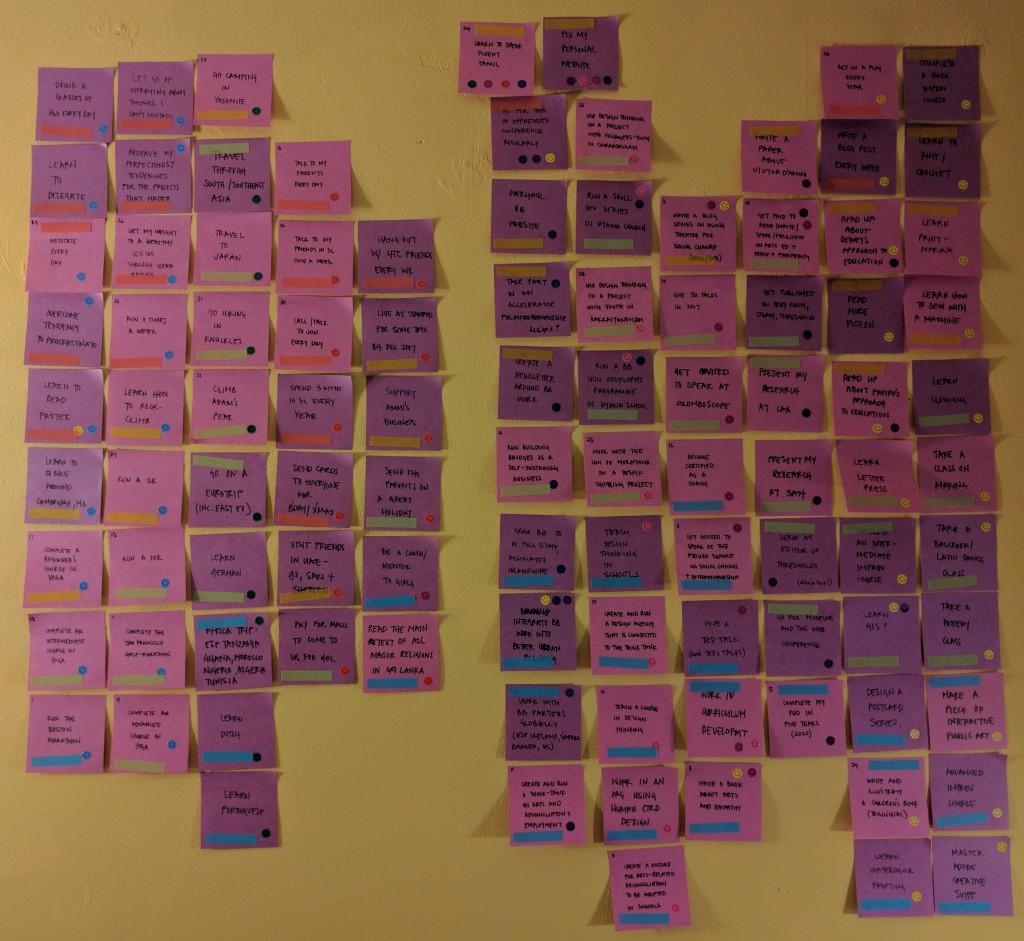Part 1: Life Audit
I chose to do the Life Audit, which got a little challenging around the 50-goal mark, but then I got a burst of inspiration towards the end. The things about having 100 goals, I’ve noticed, is that you can be a bit “wasteful”, which is a great way for figuring out what you want more of in life. In my case, it was art – opportunities to create and engage in a bit of pottering around. 27 of my post-its had a wish that was art-related, whether it was learning to knit or taking an improv class. I don’t think I can realistically take up all 27, but it’s an indicator that I need at least one.
I’m also clearly really taken up with design thinking (maybe because it so nicely fits with my need to be creative for social good) because I had the phrase on 12 post-its.
There were 14 “family and relationships” notes, 14 on my academic research (although maybe I need to revisit the ‘What if I lost everything’ exercise to see if I want these or just think I want these), 13 on expanding my work with Building Bridges, 12 on sharing my work through talks, blogs, and research, and 11 that are travel and language-related. It turns out that I’m not as hungry for new experiences as I thought I was…maybe because I already feel like I get to see and do a lot of cool new things anyway, and I can be a bit of a homebody.
I had 18 notes on mental and physical health, second only to my whopping 27 on art. I’m not surprised. I’m more tired than I’ve ever been in my life; I’ve taken on far too many things, and while I feel I now have a great deal of clarity about what things excite me, and that I want to keep doing for a while, I do have to get through a lot of other (often overdue) obligations to get there. I’m grateful for the ‘all kinds of everything’ I’ve experienced this year, but I am also very ready to be done.
I sorted everything by time, too, but I realised that I actually had no desire to obsessively graph them and make a plan. I’m thinking of it more as taking a mental temperature than a fully-fledged map to chart the future. I think I’m just going to pick a handful that feel most interesting/valuable and save the rest for another day. You can see my post-it wonderland below:
Part 2: 2017 QYL Challenge – Looking for Magic
The Challenge: Take small steps towards abundant thinking.
The Tasks: Abundance thinking really comes down to small daily practices that expand your horizons. Here are three to get you on your way.
- Practice seeing the unseen: Micci and Lee’s ‘Noticing the Moment’ ‘3C Vision’ exercises are helpful guides. Simply pick an activity you usually don’t think much about – brushing your teeth, or your morning commute. Try to spot ten things you didn’t before. Which side of your mouth do you begin brushing first? Is there a house or tree you didn’t take note of when walking? What colour is it? It’s a good way to start seeing how the world is bursting at the seams with magical things that go unnoticed every day.
- Take time to be grateful – and then tell people about it: The Self Journal in the Dropbox is a great framework for this, with space for naming three things in the mornings and evening. I encourage you to go a step further and tell people about these things, whether it’s giving someone a thank you note for past kindnesses – think back to the module with Lauren Currie – or finding more creative ways to give thanks. Giving a talk at Creative Mornings about my parents (which inspired this challenge!) gave me a warm fuzzy feeling for them that hasn’t worn off three weeks later. It’s one of the best things I’ve done this year.
- Challenge yourself to give in creative ways: None of us are very well-off, but that doesn’t mean we don’t have a lot to give, be it a friendly ear, vocal support for someone who needs it, taking the time to edit an essay or be a mock audience when your friend is practicing for a speech. It could be cleaning the kitchen for tired parents, or surprising a sibling by taking the afternoon off especially for them. Giving creatively is not about you and what you’re capable of, it’s about figuring out what people need before they say it. It’s a way to look outside ourselves and our needs, and giving will also give you a boost of joyous energy in the process.
The Benefit: You’ll notice that good things come your way more often. It’s easy to think of them as good fortune or luck, but the ability to spot what others don’t logically leads to new opportunities, a constant sense of optimistic gratitude (rather than focusing on anger or frustration) has the effect of opening you up to the world rather than closing you down, and dreaming big is likely to result in more spectacular results than thinking small.
My Experience: I’ve found that taking the time to enjoy my walk to school, or my morning tea, or any activity I’m usually doing without paying much attention, leaves me with a sense of calmness and readiness for the day, as well as gratitude that I get to do all the wonderful things I do. Being consistent about writing what I’m grateful for is harder, but well worth it for reframing a ‘bad’ day. The thing I find hardest is to dream big about giving ‘big’, and I think it’s important to remind myself that it’s not about how much I have in my bank account (but we’re so used to thinking in monetary terms that it’s hard to get out of this frame of mind) and trusting that the non-monetary things we can give are just as, if not more, valuable. Then there really is enough for everyone.
Part 3: Reflection
The ‘Island’ module has come at a really opportune time for me, even though I’ve still been so busy that I haven’t been able to retreat to my island every day, or even as often as I’d like. It’s been a way for me to check in with myself (and see how I had burdened myself with far too many things) and create some space to ask, “Well, what do I want? Where do I want to be?” I decided to be present when I went for a conference that was taking time from my PhD work – and I got more out of it than if I’d tried to balance everything. I was also invited to a dinner with Dr. Amit Sood of Mayo Clinic, who teaches on resilience and happiness – and I’m convinced it’s another sign from the universe telling me to lighten my load.
I’m still finding that hard to do, so I’ve started tracking my hours, and refusing to let myself work for more than 8 hours a day, 5 days a week. It still needs a lot of tweaking and working through, but I think it’s healthy to think of my PhD work as just another job, at least for a little while. Framing it as my vocation is both a source of inspiration and exhaustion, but in line with the question, ‘What if I lost everything?’ seeing it as just one more (fun) thing I do that needn’t take precedence over anything else helps me to budget my time better, not putting all my time-eggs in my PhD-basket.
Lastly, I was inspired to give that talk about my parents right after writing out my 30 Nice Things and Island task list. I loved giving the talk, my parents were surprised and thrilled to read it, and it resonated with a lot of friends. Thinking about it still makes me happy, so maybe my next list will be 30 nice things to give.
